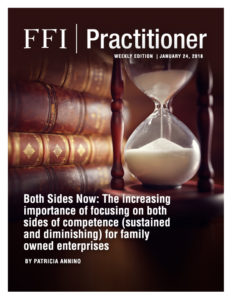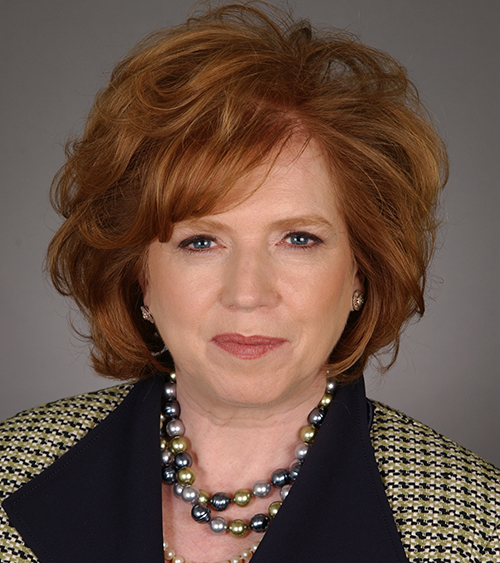
View this edition in our enhanced digital edition format with supporting visual insight and information.
This week’s article examines two sides of one issue – competency. Thanks to Patricia Annino for sharing her analysis of the challenges presented by either sustained or diminished competence in an older family founder and for providing practical steps to help family plan for these challenges.
We are in a global societal phase change and are living in a non-linear world. All of us know someone who is one-year-old, and most of us know individuals who are older than 100 years of age. All the generations are co-existing, entwining families emotionally, intellectually, physically, and financially in unprecedented ways. As advisers, we have never been in the position of planning and touching so many generations at once. A significant and fundamentally important planning challenge is how to grapple with the concept of competence –- both sustained competence and diminished competence. For the owner of a family enterprise these issues impact governance, ownership, and succession.
Sustained Competence
Sustained competence exists when an older competent family founder (“Queen Elizabeth”) chooses not to leave or step aside because she does not have to, either physically or mentally, and because she enjoys the position. The consequence of this can be a “lost generation member” (“Prince Charles”) who has waited his entire life to become the next president and majority owner of the family business, and for whom that may never happen. Instead, at his age, his advisers and planners will be advising him how to transfer his wealth to the next generation, skipping him for leadership and ownership. If he is not financially independent and has been waiting his entire life for the title and the assets, trouble may brew as he may not be able to afford to step aside financially or psychologically. Although current lost generations facing these issues may be too advanced in age for remedy, thinking about how to incorporate sustained competence in planning for future generations is advisable.
Practical Planning Steps
- Intentional Financial Planning. As part of an annual review, discuss the net worth of family members to be sure that each generation is sustainable and not dependent upon the gifts/inheritances of another generations. In the past, family members who know they are receiving a significant inheritance may not be prudent with their own financial planning as the expectancy of what he was to receive was incorporated into his planning. With sustained competence, that expected inheritance may never arrive and the lost generation member may not have the same sustained competence. Early development of sustainable personal financial plans (income and assets) is fundamental and useful.
- Understand that in a family that is economically entwined every action causes a reaction and open communication among family members is essential. When the family co-owns a business together (and perhaps also shares investments) clear and open communication is critical. It is important for the family system to understand the succession management of these common assets: who is to receive income, assets, when, and why.
- Explore creative solutions, such as intrapeneurship. Encourage family members who may never advance to where they thought they would because of the sustained competence of the older generation to pursue interests of meaning and purpose at earlier stages. Treading water and waiting on the side-lines for a day in the sun is not a prudent strategy.
- Have a board that understands these issues and is willing to put them on the table.
- Life is a movie, not a snapshot. All plans should be reviewed on an ongoing basis. As life advances, personal financial and estate planning should be reviewed and adjusted.
Diminished Competence
Diminishing competence can have a very long runway. Human nature will focus on the days all is going well, not the days that slide into weeks and then months of diminishing competence. There is no single definition of competence, leadership of the family enterprise, governance, and succession. As Jason Osher of William James College noted in Fortune, “Sumner Redstone and Donald Sterling are recent litigation cases concerning diminishing competence. Complicating the picture is the lack of uniform definitions of competence. Competency is very specific to a skill. For example, an older executive might be deemed competent to manage his own personal affairs and yet not to run a complex business.” In the same article, Dr Sanam Herfeez noted, “There is no single test for competency and usually several tests are required to gauge a person’s fitness or to manage the challenges of running a company. When it comes to determining whether a person is capable of running a Fortune 500 company being asked to spell ‘world’ backwards or count backwards by seven is not enough.”
In a trial concerning the competence of Sumner Redstone, his primary care physician stated he was mentally fit. A geriatric psychiatrist found he lacked mental capacity. Perhaps both were right?
The question of whether or not someone is competent is a very tricky one within families. Decisions such as when to take away the keys to the car are very emotionally charged. Bringing up the issue of diminished capacity with someone who knows what the discussion means is fraught with emotional peril. It means discussing a loss of personal liberty and the beginning of a walk down a very long runway.
Frequently there is no clear demarcation between competence and incompetence until the day when the demarcation line is very clear and incompetence is definite. The challenge is to handle the issue with the planning process when there is no need to. Human nature, being human nature, can be tricky. As Scarlett O’Hara said so eloquently: “I can’t think about that right now. If I do, I’ll go crazy. I’ll think about that tomorrow.”
When the owner of a family enterprise is facing diminished competence there are also issues of privacy — when is it appropriate to reveal diminished mental incapacity to the shareholders? How should the right to privacy vs the fiduciary duty to co-owners balance? We are entering a time of increased moral judgments that will impact families and family owned enterprises at their core level.
Practical Planning Steps
- Plan for disability or incapacity. This planning should be as important as financial planning and traditional “what happens when I die” estate planning. Review all “boilerplate” clauses in estate planning documents to determine who will be in charge if your client becomes disabled or incapacitated and what the trigger mechanism is (certified by your personal physician, two physicians, etc.). Make sure all documents are up-to-date and recently ratified.
- Put checks and balances in place to deal with conflicts of interest. Is the person who will be making your client’s medical decisions the same one who will be handling his financial decisions? Is there a conflict between those decision makers? For example, is the person next in line to succeed the business the same person who also has the health care proxy or the person who will handle financial affairs in the event of disability or incapacity? Is the person who is designated to handle the business issues (sign/renew the business lease, vote stock, apply for a business loan) the same person who is designated to handle these personal issues (paying bills, staying at home, etc?) The skill sets are quite different and yet when different people are designated for different roles the situation can become quite complicated. Do the persons designated for different purposes share your client’s value system and goals? Should your client set up a private mechanism to handle any conflicts? Is there a role for independent persons in these fiduciary and legal capacities? Be sure your client has updated legal documents, including a health care proxy and a durable power of attorney. Disability or incapacity could last a long time and those initially named may predecease your client or be unable to continue to serve in those capacities. Be sure your client has thought through who the backups will be, and the mechanism for appointing any successor. In the durable power of attorney, your client also has the opportunity to nominate now the person who would be his guardian or conservator if protective proceedings were commenced. This is a very important and often overlooked clause because the nominated person has legal standing in any court proceeding concerning incompetence and must be given notice of any proceeding.
- Consider carefully who should have the right to your client’s medical information and waive the right to HIPPA (Health Insurance Portability and Accountability Act of 1996). Should it just be persons who are authorized to handle your client’s medical affairs? Should it also include those who will handle your client’s financial affairs?
- Clarify to whom those individuals designated by your client with the authority to handle his financial affairs (if he is disabled or incapacitated) are legally accountable. To whom should they have to report their actions? Who has the right to review, approve, and object?
- Have a board that understands these issues and is willing to put them on the table.
In sum, it is crucial that, as advisers, we expand our thinking and understand the challenges and planning strategies around new threats to leadership and succession planning for the family enterprise in this seven-generation world.
About the contributor
 Patricia M. Annino is an attorney with Rimôn, P.C. in Boston. A member of the FFI board of directors and a frequent contributor to FFI Practitioner, she has been voted by her peers as one of the Best Lawyers in America, Estate Planner of the Year and EuroMoney’s “Best in Wealth Management — USA.”
Patricia M. Annino is an attorney with Rimôn, P.C. in Boston. A member of the FFI board of directors and a frequent contributor to FFI Practitioner, she has been voted by her peers as one of the Best Lawyers in America, Estate Planner of the Year and EuroMoney’s “Best in Wealth Management — USA.”
About Rimôn, P.C.
Rimôn, P.C. is a global law firm serving the needs of individuals and family businesses.

View this edition in our enhanced digital edition format with supporting visual insight and information.





